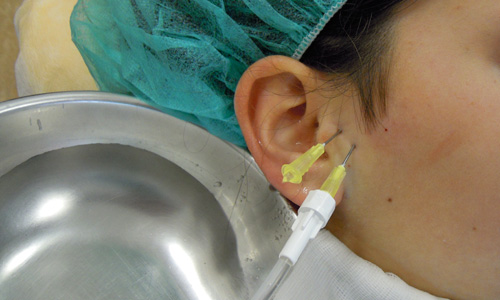- Arthrocentesis
- What is arthrocentesis and how is it performed?
Arthrocentesis is the more simple surgical technique and is less invasive for the temporomandibular joint and consists of a joint lavage.
Arthrocentesis is performed under local anesthesia on an outpatient basis and is a completely painless procedure.
Two needles are inserted within the upper articular compartment and the joint is washed with saline.
After lavage, the hyaluronic acid is instilled into the joint and a delicate mandibular manipulation is carried out in order to evaluate all joint movements.
Patients after arthrocentesis can immediately go home and go on with their normal life.
The post-surgical therapy involves the use of anti-inflammatory drugs/painkillers accompanied by articular physiotherapy and the use of the splint.

Arthrocentesis of the temporomandibular joint
What is the effect of arthrocentesis and what are the results?
Through washing, it's possible to eliminate those substances that cause inflammation and pain; the adherences are removed and the joint regains its normal function. The pathological synovial fluid is eliminated thus allowing the production of new non-pathological synovial fluids. The articular disc, which in the pathological joints adheres as a suction cup to the tissues, regains its function.
Hyaluronic acid has instilled within the joint performs a visco-supplementation and anti-inflammatory/analgesic action.
The aim and purpose of this joint lavage are as follows: reduction of the joint load, reduced inflammation, improved mandibular movements and especially pain control.
The recovery of the disc with a displacement through the arthrocentesis, is possible only for the displacement of recent (acute) onset; however, the improvement in symptoms, and success of the procedure, is not dependent on the possible recapture of the disc.
Although arthrocentesis helps to improve the symptoms, it is not able to eliminate the causes. It is essential therefore to treat the possible causes such as clenching or bruxism with the splint that is a complementary therapy.
It is also important to begin the drug therapy and physiotherapy.
The scientific literature supports the use of arthrocentesis to improve the mandibular function and reduce the pain with a success rate that varies from 70% to 95%. This success rate is, however, influenced by the time spent by the onset of the symptoms.
The arthrocentesis is much more effective in acute than chronic disease and thus the earlier you perform arthrocentesis, the greater chance of success there will be.
The limits of arthrocentesis are due to the fact that it is a procedure performed that does not give information on the pathological anatomy of the joint.
